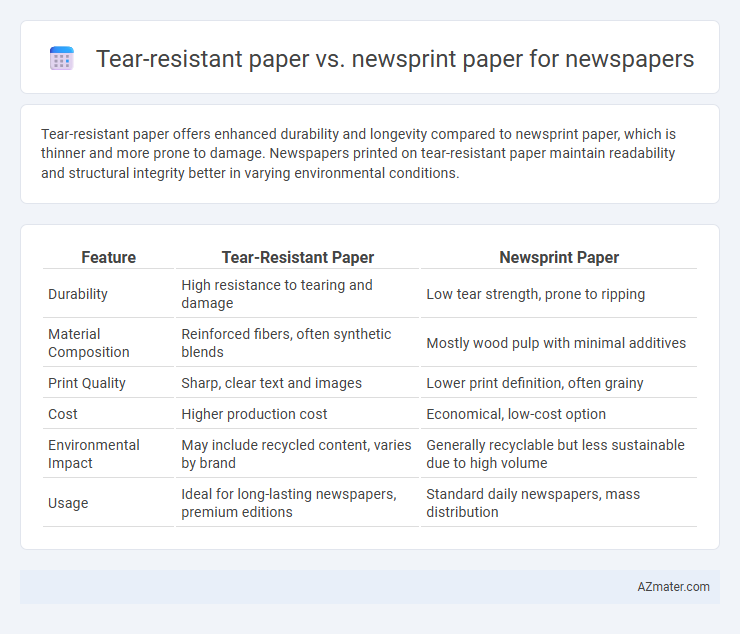Tear-resistant paper offers enhanced durability and longevity compared to newsprint paper, which is thinner and more prone to damage. Newspapers printed on tear-resistant paper maintain readability and structural integrity better in varying environmental conditions.
Table of Comparison
| Feature | Tear-Resistant Paper | Newsprint Paper |
|---|---|---|
| Durability | High resistance to tearing and damage | Low tear strength, prone to ripping |
| Material Composition | Reinforced fibers, often synthetic blends | Mostly wood pulp with minimal additives |
| Print Quality | Sharp, clear text and images | Lower print definition, often grainy |
| Cost | Higher production cost | Economical, low-cost option |
| Environmental Impact | May include recycled content, varies by brand | Generally recyclable but less sustainable due to high volume |
| Usage | Ideal for long-lasting newspapers, premium editions | Standard daily newspapers, mass distribution |
Introduction to Tear-Resistant Paper vs Newsprint Paper
Tear-resistant paper offers enhanced durability and strength compared to traditional newsprint paper, making it ideal for newspapers that require longer handling and improved lifespan. Newsprint paper, primarily composed of wood pulp with minimal processing, is lightweight and cost-effective but prone to tearing and yellowing over time. The choice between tear-resistant and newsprint paper impacts print quality, longevity, and production costs in newspaper publishing.
Composition and Material Differences
Tear-resistant paper for newspapers features a higher percentage of synthetic fibers or special resin coatings, enhancing durability and resistance to ripping compared to traditional newsprint, which is primarily composed of mechanical pulp from softwood fibers. Newsprint paper contains more lignin and shorter fibers, making it lightweight and cost-effective but prone to tearing and yellowing over time. The incorporation of synthetic content in tear-resistant variants results in improved moisture resistance and strength, ideal for publications requiring longer shelf life and better handling.
Durability: Tear Resistance and Wear
Tear-resistant paper for newspapers offers superior durability with enhanced fibers and coatings designed to withstand rough handling, reducing the likelihood of rips and tears during distribution and reading. Newsprint paper, while cost-effective and lightweight, typically has lower tensile strength and is more prone to wear and tearing, especially when exposed to moisture or frequent folding. The enhanced tear resistance of tear-resistant paper extends the lifespan of newspapers, making it ideal for editions requiring longer shelf life and better reader experience.
Print Quality and Image Clarity
Tear-resistant paper offers superior print quality and enhanced image clarity compared to newsprint paper, thanks to its durable fibers that prevent ink bleed and smudging. Its smoother surface allows for sharper text and more vibrant images, resulting in crisper, more professional-looking newspapers. Newsprint, while cost-effective, tends to absorb ink unevenly, causing blurred images and lower print resolution.
Environmental Impact and Sustainability
Tear-resistant paper for newspapers typically uses synthetic fibers or chemical treatments that reduce biodegradability and complicate recycling processes, increasing environmental impact compared to traditional newsprint paper. Newsprint paper, composed mainly of recycled fibers and sourced from sustainably managed forests, offers greater sustainability through easier recycling and lower resource consumption. Choosing newsprint paper supports a circular economy and minimizes landfill waste, advancing eco-friendly newspaper production.
Cost Comparison and Economic Feasibility
Tear-resistant paper typically costs 30-50% more than newsprint paper, impacting the overall budget for newspaper production. While newsprint paper is the cheapest option, making it economically feasible for large-scale daily printing, tear-resistant paper can reduce losses from damaged copies, potentially saving money in distribution and increasing customer satisfaction. Choosing between the two depends on balancing initial paper costs with long-term durability and revenue retention.
Handling and Transportation Benefits
Tear-resistant paper offers superior durability during handling and transportation compared to traditional newsprint paper, reducing the risk of rips and damage in stacks and bundles. Its enhanced fiber composition ensures that newspapers maintain integrity even under rough handling or adverse weather conditions, minimizing losses during shipment. In contrast, newsprint paper is more prone to tearing and wear, leading to increased waste and higher costs in distribution logistics.
Reader Experience and Usability
Tear-resistant paper enhances reader experience by offering durability and resistance to damage, making newspapers easier to handle and prolonging their lifespan. Newsprint paper, widely used for its low cost and lightweight nature, can easily tear, which may frustrate readers and reduce usability in daily handling. Choosing tear-resistant paper improves overall usability by supporting multiple folds and rough handling without compromising the integrity of printed content.
Industry Adoption and Trends
Tear-resistant paper is increasingly preferred by major newspaper publishers due to its durability, allowing newspapers to withstand handling and weather exposure without damage, thereby enhancing reader experience and reducing waste. Newsprint paper remains widely used because of its cost-effectiveness and recyclability, maintaining dominance in budget-conscious markets and short-term publications. Industry trends indicate a gradual shift towards tear-resistant options as environmental concerns and consumer demand for higher quality print media drive innovation in paper manufacturing technologies.
Conclusion: Choosing the Right Paper for Newspapers
Tear-resistant paper offers enhanced durability and longevity, making it ideal for newspapers that require extended handling and archival quality. Newsprint paper remains a cost-effective option with adequate print clarity but is prone to quick wear and tear, suitable for short-term distribution. Selecting the right paper depends on balancing budget constraints with the desired newspaper lifespan and reader experience.

Infographic: Tear-resistant paper vs Newsprint paper for Newspaper
 azmater.com
azmater.com